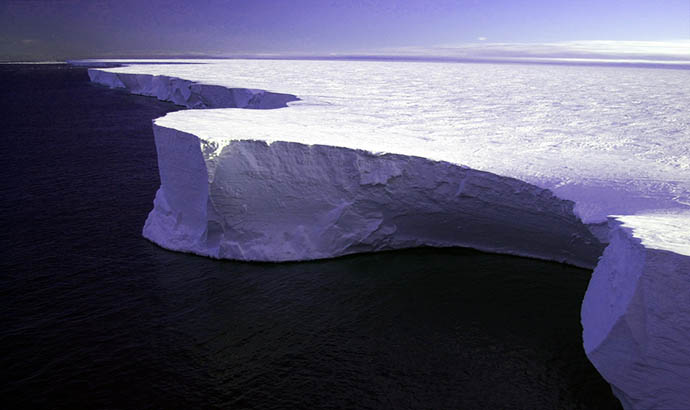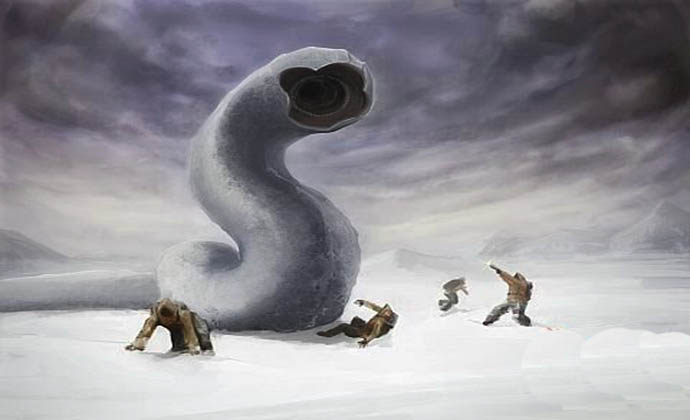
Antarctica met the first researchers by a boundless ice wall. The greatest ice massif on Earth occupies the space almost equal to the territory of France. Frightening look. Against an ice shelf of Ross turned to the sea by a steep wall everything looks tiny: people, vessels, whales and even the icebergs which are breaking away from this monolith. These ice steep rocks blocked a way to the first researchers of Antarctica. However then the plain surface of a glacier was the ideal place of start for expeditions to the South Pole. Unique endurance. An imperial penguin – the only animal who is throwing down a challenge to the Antarctic winter, removing and bringing up here the posterity. The only eggs are laid on ice and hatched out by a male. When the baby bird hatches, both parents take part in his bringing up. Expedition of the British admiralty slowly progressed on January 5, 1841 through pack ice to Antarctica. Two three-mast vessels, “Erebus” and “Terror” which wooden cases were specially strengthened were its part. Attempt to establish location of the South magnetic Pole was the purpose of expedition. On January 11 before travelers the huge wall of ice grew. “Yes, to pass here – it is all the same what to pass through the rocks of Dover”, – the head of expedition sir James Clark Ross exclaimed. In 1831 Ross established location of the North magnetic Pole and within the next two years unsuccessfully tried to find sea pass to the South Pole. After his name the ice shelf and the sea washing it will call. The ice shelf of Ross literally fills with itself the huge gulf crashing deep into the Antarctic continent. From the West on the East the glacier stretches almost for 800 km, from Edward VII’s peninsula to Ross Island, and on 970 km crashes deep into the continent. Steep ice breaks from the sea reach places of 60-meter height. At slightly hilly southern borders of a glacier located most closer to the earth, thickness of ice can reach 750 m. The glacier constantly moves to the sea with a speed from 1,5 to 3 m a day. Birdmor’s glacier and several other large glaciers, climbing down the remote Transantarctic Mountains, press on an ice shelf of Ross and increase his weight. The cracks and breaks arising along internal border of a glacier can last on many kilometers, often forming wide gullies. When the big mass of ice is surrounded with such gullies from all directions, from an outer edge of a glacier huge ice slopes break away. The largest of the known icebergs had the area about 31 000 square kilometers, it is a little more than territory of Belgium. Throughout many centuries the southern polar regions remained unopened and not plotted though still ancient Greeks considered that in the Southern hemisphere there has to be a huge continent which would counterbalance the northern continent Eurasia. This belief found reflection on all old European cards. Even the great Flemish cartographer Merkator (1512-1594) imprinted on the card around the South Pole the huge continent called by it Terra australis incognita. Two hundred years later the English seafarer James Cook for three years (1772-1775) was engaged in searches of this continent. It did not find any proofs of its existence though swam away to the south 70 ° SL. Nevertheless, Cook was convinced that “near a pole there is a strip of the earth with which ice also spreads on this huge Southern ocean”. In 1820 the crew of the research vessel of the British royal Navies from a distance observed Antarctic Peninsula, and the next year the first hunters landed there. Several years later seals hunters were succeeded by kitobo. Thickness of snow and ice in Antarctica sometimes exceeds 3500 m. It is the highest continent on Earth. A half of its territory towers above sea level more than on 2000 m Besides, there is a set of active volcanoes. One of the largest – Mount Erebus on Ross Island. Antarctica is considered the driest place on Earth, the land, than the Sahara. In internal areas of the continent only about 50 mm of rainfall, and at the coast – 500 mm drop out annually. It also the coldest place on Earth. Temperature can go down so strongly here that the boiled water which is splashed out in air right there turns into ice crystals. Though the ice shelf of Ross represented an enormous obstacle for researchers, eventually, it helped them to reach internal areas of this severe earth. Scientists found fossilized remains of animals and plants here that demonstrates that Antarctica was once part of the ancient supercontinent of Gondwana. Besides, conducting researches in Antarctica, they found out that in an ozone layer of the atmosphere there is a hole.




Leave a Reply